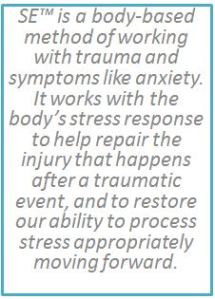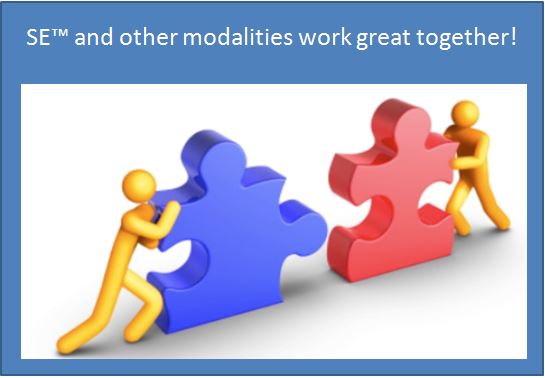Once you start having Somatic Experiencing™ sessions, you might want to tell your other helping professionals what you’re up to. People often say, “I told my doctor I was coming here and tried to explain it, but I don’t know if I was saying the right thing.” Sometimes clients want me to talk to their psychiatrist, psychologist or doctor. With time constraints that some professionals have, it might be important to have something you can say succinctly so that they get the idea.
If you’re planning to talk to a professional, consider the following first:
- What is your relationship with this provider? Is it someone you see for 10 minutes every few months for a medicine check or is this a weekly 50-minute visit with a trusted therapist?
- Is the provider focused more on medical interventions, psychological treatment or both?
- What information about your Somatic Experiencing™ sessions will impact their treatment with you?
- Is this an insurance company that needs details relevant to submitting a claim?
Here are some general things I consider when speaking to other professionals:
Psychiatrists: Individual practitioners vary, but I usually start by trying to meet them where they’re at. Generally people seeing a psychiatrist only see them periodically for medicine checks. They will be interested in knowing if anything you’re doing is going to impact the medicines you’re taking. In my experience, SE™ often works subtly in a very steady way. Most psychiatrists don’t make changes to meds based on our work together, especially in the beginning. Clients stay on their usual prescribed medications until they talk to their doctor about making adjustments. This usually doesn’t happen until things have gotten very easy for the client, usually after months or years have passed.
Occasionally along the way we might get to a point in which anxiety increases for a period or things get “bumpy” as they integrate. It will be up to you and your doctor to decide whether this is manageable, whether an adjustment to your meds is necessary, or if we need to slow things down in our work to gain more stability.
What to say about SE™: I’m doing some work with an MFT who uses a method called Somatic Experiencing™ (SE™). She’s working with my stress response to help my nervous system learn to stop responding as if my trauma were in the present. It’s a body based treatment for working with trauma.
 Psychologists and other Mental Health Therapists: If you’re seeing a therapist weekly, it might be helpful for us to speak directly so that they know what aspect I’m working with while they work on something else. When it’s a good fit, this can be a very helpful alliance for your healing. I’ve collaborated with therapists who are concentrating on helping clients work on negative thought patterns, relationship strengthening, and parenting concerns, etc., while I focus on aspects of developmental trauma and helping the autonomic nervous system learn to process stress in a more regulated way. It isn’t always possible for clients to have two therapists, so in those cases I do some of the traditional psychotherapy elements as we go.
Psychologists and other Mental Health Therapists: If you’re seeing a therapist weekly, it might be helpful for us to speak directly so that they know what aspect I’m working with while they work on something else. When it’s a good fit, this can be a very helpful alliance for your healing. I’ve collaborated with therapists who are concentrating on helping clients work on negative thought patterns, relationship strengthening, and parenting concerns, etc., while I focus on aspects of developmental trauma and helping the autonomic nervous system learn to process stress in a more regulated way. It isn’t always possible for clients to have two therapists, so in those cases I do some of the traditional psychotherapy elements as we go.
What to say about SE™: I’m working with a Somatic Experiencing™ Practitioner who is an MFT. She will be focusing on working with past trauma and symptoms of stress (including anxiety and depression). She is happy to speak with you about her work and answer any questions. SE™ is a body-based method for working with stress. She says that working with another therapist is a great complement to her work. You can look at her website if you want to get a little more information.
Insurance Companies: Whether it’s a medical insurance company or an auto accident claim, insurance companies want to know whether you are being treated by a professional who is treating the issue you are being covered for using a treatment method that is approved by your insurance provider. In the case of Somatic Experiencing™, the method itself is in early stages of gaining research to support its effectiveness. If you are trying to claim Somatic Experiencing™ treatment, you will need to see a provider who will also be doing something else your insurance approves for your claim, like psychotherapy.
What to say about your treatment: Consider SE “bonus” work, and share with your insurance company what approved methods you were using in addition to SE™, such as cognitive behavioral therapy or psychotherapy for trauma.
Chiropractors, Physical Therapists or other Body Workers: If you are working with a provider for physical healing, it can be very important for you to help them understand how to work at a pace that’s safe enough for your system.* As you learn more about your body’s stress response, you will become more familiar with what happens when your body is getting stimulated in a way that is too much. For some clients it becomes a time of having to be very specific about asking for what you need and being willing to find a new practitioner if they are not willing to listen. Some practitioners have a strong emphasis on getting the body functioning again and an acceptance that pain may be involved. SE™ Practitioners believe that titrating treatments is usually a more gentle and effective way to help the body shift. If you do too much, too fast, there is a possibility of reinforcing the trauma pattern or your body will be fighting against the work the practitioner is trying to do.
What to say about SE™: I am working with a Somatic Experiencing™ Practitioner to help work with trauma. I’m learning how to feel trauma signs and PTSD symptoms in my body. She said it’s important to let you know if I start feeling them during our treatments, and that it will be helpful if I feel them too strongly, if we can take breaks or slow things down. [You may need to talk to your practitioner about whether slowing down will impact your treatments, for example if you have a limited number or sessions covered by your insurance. You’ll have to weigh whether it is more important to get relief from the physical aspects first and then our SE™ sessions will focus on stabilizing your system from activation that comes up in those treatments.]
*This actually applies to all types of treatment, including mental health interventions that use catharsis as part of treatment.
I hope this gives you some ideas about how to talk to practitioners. For most of them, less is more. For practitioners who are curious (many become curious when they see things change for you!), you can direct them to my website, brandyvanderheiden.com or www.traumahealing.org for more information.
Happy healing!



